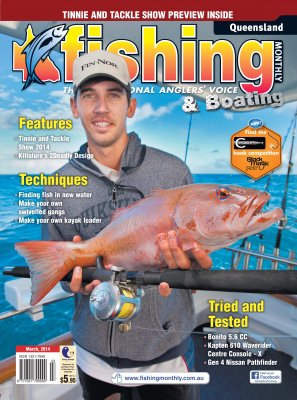Finding fish on new waterways by Roderick Walmsley
 There was already a boat anchored in the bay we were heading towards so we lowered the electric and slowly worked past him.
There was already a boat anchored in the bay we were heading towards so we lowered the electric and slowly worked past him.
We wanted to investigate the shallow, rocky flat just past his boat and seeing as we were new to the area didn't think the best way to make friends was to go flying past other anglers on the plane. Therefore we slowly headed over to the flat checking out the rocks and channel edge as we went. It was the first time that Goodie and myself had been on the waterway and had already done 70km for the day exploring its plethora of creeks.
The Minn Kota slowly pulled us closer to the flat and as we made our way along it, we noticed a fish mooching around in about 6" of water. It looked to be a king threadfin salmon. The only reason it would be in such shallow water in the middle of the day would be to feed. I lined the boat up and fired in a cast. The fish didn't react so Goodie put his cast right on its nose. It swung around and followed the lure without eating. As it turned away I put another cast passed the fish and banged the lure into the bottom. This fired it up! It showed a lot more sign of eating but once again didn't commit. Goodies next cast was the one. He twitched the lure twice and the fish engulfed it. He struck and the big fish teared across the flat stripping line as it went! After a solid fight I stuck the net under it and lifted the fish into the boat.
It turned out to be a blue salmon right on the magic metre mark. It was the fish of the day and thinking back to it now, we probably wouldn't even have seen it if we weren't so intent on getting to know the new system as well as being cautious with regards to the rocks in the creek and being courteous to our fellow angler.
We often read about innovations that help us to find or catch fish, about the 'latest and greatest' tackle or the newest electronic aid, but I would have to say that we often overlook a very important aspect of fishing. You still need to find the fish first, or at the very least put yourself in fishy areas of the waterway.
Yes the right lures, hooks, reels and rods are some of the things that will help you catch more fish and are things that many of us fishos rely on for our day-to-day fishing trips. We do however have to be in a fishy area to make the best use of these things in the first place.
There are basically two kinds of human beings out there: there are those, which are probably in the majority, that are bound to their grassroots and spend most of their working lives in or around a very similar area. They fish the same creeks or rivers at regular intervals and become quite accustomed to these waterways over time. The odd foray into unknown territory over their much-needed holidays or a guided charter is about the extent of their exploratory needs.
The second group is more nomadic and generally follow contractual work around our lovely country. Some move their families with them and the boat is never far behind. This type of lifestyle leads to constant exposure to new waterways.
Working out your own local fishery can be challenging enough, without having to deal with a new system on a regular basis. Navigating on these new and foreign waterways can be a mission in itself let alone actually finding and ultimately catching fish. Several factors can play a big role in helping us get closer to our next bite. Let's take a look at some of the things that can be a big help.
TECHNO SAVVIE
Modern technology does have some very effective tools that we can use. Google Earth is probably one of the biggest of these. There are variations of Google Earth that can often show certain areas better than others; it can pay to look at a system, and then at it again with the alternative version of Google Earth.
Study the area you intend fishing prior to heading out. You will be able to view it at different stages of the tide and this will help to identify fishy looking areas as well as obstacles that may require careful navigation. A good tip is to print out some of the key areas you intend investigating and even saving the GPS coordinates and adding them to your on-board GPS. Once you have printed these pictures they can be laminated and kept in your boat for constant referral. Keep consulting them as you move around as you may drive past an area that doesn't look at that good on the high tide, because the fish attracting structure may be under the water at the time you drive past.